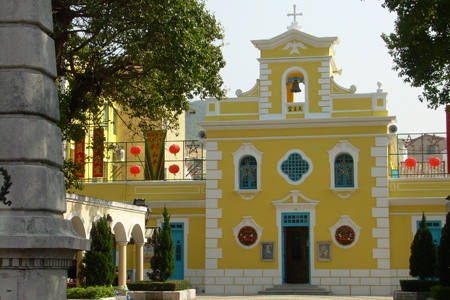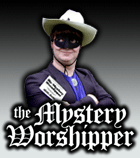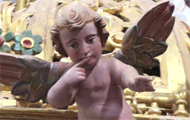 |
||||||||||
 |
||||||||||
|
1489: St Francis Xavier, Coloane Island, Macau Mystery Worshipper: Amaranta. The church: St Francis Xavier, Coloane Island, Macau. Denomination: Roman Catholic. The building: This beautiful little mustard-coloured church on the southern coast of Coloane Island was built in 1928 in the style typical of Portuguese colonial architecture, somewhat reminiscent of the Baroque. The church sits at the end of a colonnaded courtyard. For years it existed in a run-down condition, having been used as a chapel for soldiers from Mozambique serving in the Portuguese Army. But it has been lovingly restored. When we visited, there were banners, lanterns and fairy lights hung outside, perhaps for the approaching Chinese New Year. The symmetrical facade with light blue woodwork is topped by a pediment with bell. The interior was decorated a little too gaudily for my taste, featuring several arrangements of artificial flowers and some rather kitschy prints of religious subjects, as well as an eye-catching mural representing Jesus surrounded by flames. The church used to house several relics, including a fragment of bone from the arm of St Francis Xavier, who died of fever on Sanchuang Island, just south of Macau, in 1552; these all now rest elsewhere. The church: The parish serves a community of both local Macanese and expats. In fact, the only advertised Sunday mass is conducted in Cantonese and English. The parish priest is Filipino. It was interesting to recognise members of the congregation in photos of past episcopal visits and parish activities, such as a community stations of the cross. The neighbourhood: Formerly a Portuguese colony, Macau was handed over to China in 1999. Although China is responsible for its defence and foreign affairs, the territory enjoys considerable autonomy. Macau is becoming increasingly famous for its gambling scene. The island of Coloane was still the haunt of pirates as recently as 1910, but these days the foreign visitors are golfers, hikers and beach bunnies. Coloane is Macau's countryside, with wooded hills, beach-lined bays, and traditional villages. It's a quiet place, primarily a residential area for people working on the Macau peninsula. It is also home to a bakery which claims to have perfected the nata, or Portuguese egg tart. The church is in the centre of the waterfront, fronting a square with a fountain, several cafés and a monument recalling a local victory over pirates in 1910. The cast: The Revd Ramon Abadicio Manalo, parish priest, better known as Father Ramon. He was assisted by two altar boys, an acolyte, and a variety of readers. The date & time: 28 January 2007, 10.00am. What was the name of the service? Chinese-English mass. How full was the building? Cosy. All the pews were full, and there were several worshippers sitting on fold-up chairs in the side aisles. This appears to happen on a regular basis, as the chairs were stored handily along the wall for this purpose. Did anyone welcome you personally? Not at first, but things improved as time went on. A few people smiled at us as they came in, but we were earlier than most. Later, during the peace ceremony and the Lord's Prayer, and after mass, people were more friendly. Was your pew comfortable? Adequate. The pews were simple wooden numbers, but there was plenty of leg room and the kneelers were padded. How would you describe the pre-service atmosphere? Recorded organ music was playing in the background, but as the church filled, this was drowned out by members of the congregation greeting one another and parents settling babies. We had to help ourselves to a hymnbook and service leaflet, hoping we'd selected the right ones from the bewildering array of literature on the table. What were the exact opening words of the service? A lector said "Good morning" and then read from the service leaflet: "When the child Jesus was presented at the temple, the old man Simeon prophesied that he would be a sign that would be contradicted." What books did the congregation use during the service? The English liturgy was from a leaflet entitled Sambuhay, produced by the Philippine Society of St Paul. Some hymns were taken from a Chinese hymnal whose name in English is Thoughts of Praise. What musical instruments were played? Organ and handbells. Did anything distract you? Three mobile phones and one baby. I also kept catching in the corner of my eye people moving in and out, and spent some time wondering where they were going and why. I later concluded that they'd been slipping out with the children for Sunday School. Was the worship stiff-upper-lip, happy clappy, or what? Bells (but no smells) modern Catholic – of the touchy-feely variety. Before the peace ceremony, the entire congregation got out of the pews and joined hands in a circle for the Lord's Prayer, and so the ensuing passing of peace was quite lively. A mother holding a baby who had been crying earlier in the service brought the baby with her into the circle, and it was very moving to see people holding the baby's hands and the calmative effect it had. Exactly how long was the sermon? 4 minutes English, 7 minutes Cantonese, for a total of 11 minutes. On a scale of 1-10, how good was the preacher? 7 – I can't comment on the Cantonese, but his English was very good and easy to understand. In a nutshell, what was the sermon about? Basing his sermon on 1 Corinthians 13 ("And now these three remain: faith, hope and love. But the greatest of these is love.") he posed the question: "What should we be doing with our lives?" The answer was that the most important thing a person can do is learn how to love. Which part of the service was like being in heaven? The welcome we received from the congregation after they had gotten warmed up, and the handbells. And which part was like being in... er... the other place? I was worried that I had not taken the correct service books, and struggled now and then to figure out exactly where we were in the mass. But that's to be expected in a bilingual environment. What happened when you hung around after the service looking lost? A few different people introduced themselves and made light conversation. We weren't aware that the relic of St Francis' arm had been moved, and took ourselves into a side room in the hopes of seeing it. Unfortunately, we had to content ourselves with various photos and other memorabilia. How would you describe the after-service coffee? There was none – but the fried tofu at the restaurant next door was delicious. How would you feel about making this church your regular (where 10 = ecstatic, 0 = terminal)? 9 – I particularly enjoyed worshipping with a mix of expats and locals, and appreciated the effort that makes this possible, despite the linguistic difficulties. Did the service make you feel glad to be a Christian? Yes, very much so. The friendliness of the people more than made up for the tackiness of some of the interior decorations. What one thing will you remember about all this in seven days' time? Holding hands with the baby during the peace ceremony. |
|
|
||||||||||||||||||||||||||||||||||||
| More Mystery Worshipper reports | |||||||||||||||||||||||||||||||||||||||
 |
|||||||||||||||||||||||||||||||||||||||






